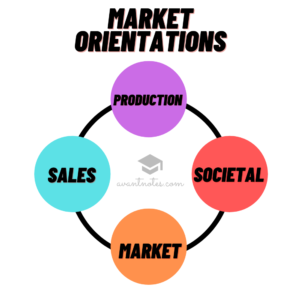Basics of Marketing
In order to begin our journey discovering what marketing is all about, we have pulled two common definitions for marketing:
The activity, set of institutions, and processes for creating, communicating, delivering and exchanging offerings that have value for customers, clients, partners and society at large.
(Lamb, et al., 2015)1
Marketing refers to activities a company undertakes to promote the buying or selling of a product or service. Marketing includes advertising, selling and delivering products to consumers or other businesses.
(Twin, 2020)2
While the majority of marketing is promoting a product or service. Furthermore, it also greatly focuses on delivering value. In today’s business world, there is competition everywhere. Therefore, it is crucial for businesses to have a successful marketing plan. You and your company must show why your product delivers more value than your competitors. That is the end goal.
Concept of Exchange
Now that the definition of marketing has been explained, we will move on to the most basic concept in business: the concept of exchange. Exchange is the heart of marketing. In business, you must always give something of value to get something of value. A common example is buying something with money. You are essentially exchanging money (something of value) for something else that you want or need that brings value to your life.
Exchange is when people give up something of value in order to receive something of value they would rather have.
(Lamb, et al., 2015)3
When two or more people trade goods or services.
(Chron, 2020)4
Moreover, there are the 5 conditions that must be met for any type of exchange to happen:
- Having least two parties
- Every party must have something that is considered valuable to the other party
- The parties must be able to communicate
- All parties are free to accept and reject the offers
- Each part must want to deal with the other party
Marketing Management Philosophies
Moving on, the next part will be about marketing philosophies. In this section, we learn what the firm wants to focus on in terms of their products or services. There are four main marketing philosophies that we will look at in this section.
Product Orientation
Firstly is product orientation philosophy. This philosophy mostly focuses on the firm’s internal ability to produce quality cheaper products.
A philosophy that focuses on the internal capabilities of an organisation, rather than on the desires and needs of the marketplace (Lamb, et al., 2015).5
Internal capabilities refers to the resources that the company has and what they can do with it. In terms of services, the concept does change a slight bit. Instead, the company identifies what services are the easiest and most convenient to perform.
Disadvantages to this orientation includes ignoring the need to produce products that meet the needs of the market.
Sales Orientation
Moving on is sales orientation philosophy. Companies with this orientation has aggressive sales techniques as they believe that will increase sales.
A philosophy that people will buy more goods and services if aggressive sales techniques are used and that high sales = high profits. (Lamb, et al., 2015).6
Despite the fact that this orientation may bring short term benefits, there are a few long-term disadvantages. Companies can fail to understand what is important to the firm’s customers. Similar to product orientation, this philosophy may result in the lack of understanding of the market.
Market Orientation
Thirdly is market orientation. Unlike product and sales orientation, market orientation focuses on customer satisfaction while still meeting organisational objectives.
A philosophy that assumes that a sale depends on a customer’s decision to purchase a product (Lamb, et al., 2015).7
The main purpose of this philosophy is not on what the business thinks it’s products, but more so what the consumers perceived value of their products.
Perceived value is the customer’s own perception of a product/service’s merits, value or desirability to them WHEN compared to a competitor (Kopp, 2020)8.
In other words, it is how much customers are willing to spend on your products based on how much value they think your products hold.
The market orientation philosophy heavily relies on a concept called the marketing concept.
The idea that the social and economic justification for an organisation’s existence is the satisfaction of customer wants and needs, while meeting the organisational objective. Thus, there’s no reason for a consumer to purchase from a competitor unless they perceive better value from the exchange.
In order to help you better identify this concept, here are some characteristics of the marketing concept:
- Focuses on the needs and wants of consumers so that the organisation can differentiate its products/services to its competitors.
- Integrating organisational activities and resources to satisfy the consumers’ wants
- Obtaining long-term organisational goals by satisfying the market legally.
Societal Marketing Orientation
Lastly is societal orientation. As the name itself says, this orientation focuses on the surrounding society. Sometimes delivering what the consumers want is not good for other individuals or society.
The idea that an organisation exists not only to satisfy customer needs and wants and organisational objectives, but also to preserve or enhance an individual’s and society’s long-term best interests (Lamb, et al., 2015).9
The purpose of this philosophy heavily lies on the want to help less privileged communities. This include fair prices (not highly inflated for profits) for goods and services. However, this philosophy was not supported until the early 2000s. Gradually over time, consumers has became more wary about sustainability. As a result, this orientation has gradually become more successful.
Overview of the Philosophies

Footnotes
- Lamb, C. W., Hair, J. F., McDaniel, C., Summers, J., & Gardiner, M. (2015). MKTG (3rd ed.). Melbourne, Australia: Cengage.
- Twin, A. (2020). Marketing. Retrieved from https://www.investopedia.com/terms/m/marketing.asp
- Lamb, C. W., Hair, J. F., McDaniel, C., Summers, J., & Gardiner, M. (2015). MKTG (3rd ed.). Melbourne, Australia: Cengage.
- Chron. (2020). What is a marketing exchange? Retrieved from https://smallbusiness.chron.com/marketing-exchange-61868.html
- Lamb, C. W., Hair, J. F., McDaniel, C., Summers, J., & Gardiner, M. (2015). MKTG (3rd ed.). Melbourne, Australia: Cengage.
- Lamb, C. W., Hair, J. F., McDaniel, C., Summers, J., & Gardiner, M. (2015). MKTG (3rd ed.). Melbourne, Australia: Cengage.
- Lamb, C. W., Hair, J. F., McDaniel, C., Summers, J., & Gardiner, M. (2015). MKTG (3rd ed.). Melbourne, Australia: Cengage.
- Kopp, C. M. (2020). Perceived value. Retrieved from https://www.investopedia.com/terms/p/perceived-value.asp.
- Lamb, C. W., Hair, J. F., McDaniel, C., Summers, J., & Gardiner, M. (2015). MKTG (3rd ed.). Melbourne, Australia: Cengage.


